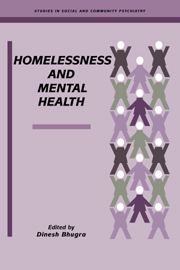Book contents
- Frontmatter
- Contents
- List of contributors
- Preface
- Part I INTRODCTION AND SPECIAL GROUPS
- 1 Introduction
- 2 Homelessness and mental illness: a brief history
- 3 Models of homelessness
- 4 Young homeless and homeless families: a review
- 5 Homeless women
- 6 Homelessness and criminality
- Part II SERVICES
- Part III INTERNATIONAL PERSPECTIVE
- Part IV POLICY AND EVALUATION
- Index
3 - Models of homelessness
from Part I - INTRODCTION AND SPECIAL GROUPS
Published online by Cambridge University Press: 15 October 2009
- Frontmatter
- Contents
- List of contributors
- Preface
- Part I INTRODCTION AND SPECIAL GROUPS
- 1 Introduction
- 2 Homelessness and mental illness: a brief history
- 3 Models of homelessness
- 4 Young homeless and homeless families: a review
- 5 Homeless women
- 6 Homelessness and criminality
- Part II SERVICES
- Part III INTERNATIONAL PERSPECTIVE
- Part IV POLICY AND EVALUATION
- Index
Summary
Introduction
There is no single definition of homelessness accepted by all who use this term. Homelessness exists throughout this and other nations as will become extremely clear in the accounts in this book, and the homeless population is diverse.
In the UK, the National Assistance Act of 1948 requires every local authority to provide ‘temporary accommodation for persons who are in urgent need thereof, being need arising in circumstances that would not reasonably have been foreseen’. Hence, local authorities have a statutory obligation to provide accommodation to individuals who are roofless, and have not placed themselves in this state. In practical terms, this definition of homelessness is probably the most important one for individuals living in the UK. When these conditions are fulfilled, local authorities have a statutory obligation to act and provide shelter to the homeless person.
Whether individuals have been ‘blameworthy’ in becoming homeless, or not, remains an arbitrary decision made by local authorities. Because resources are scarce, a narrow working definition of homelessness tends to be used. Local authorities are more likely to embrace the needs of homeless families, rather than the single homeless, hence the latter group are more likely to be excluded, under the terms of the Act.
Voluntary agencies working with homeless people have tended to use a far broader definition of homelessness. The charity Shelter working for the homeless, for instance, extends the definition of homelessness to those living in very bad housing conditions. Thus people living in very poor quality housing, or sleeping over with friends on a temporary basis, or squatting in a derelict flat would also be defined as homeless.
- Type
- Chapter
- Information
- Homelessness and Mental Health , pp. 26 - 40Publisher: Cambridge University PressPrint publication year: 1996
- 4
- Cited by

